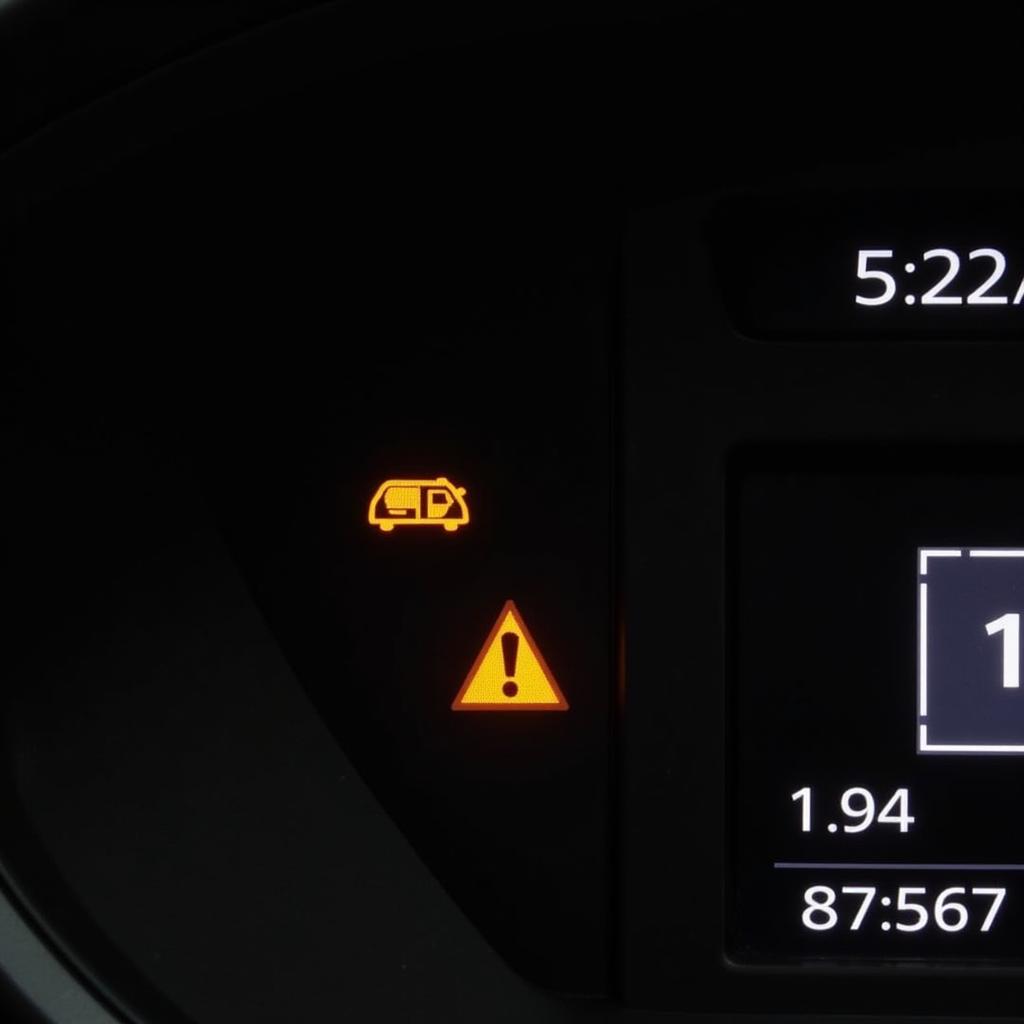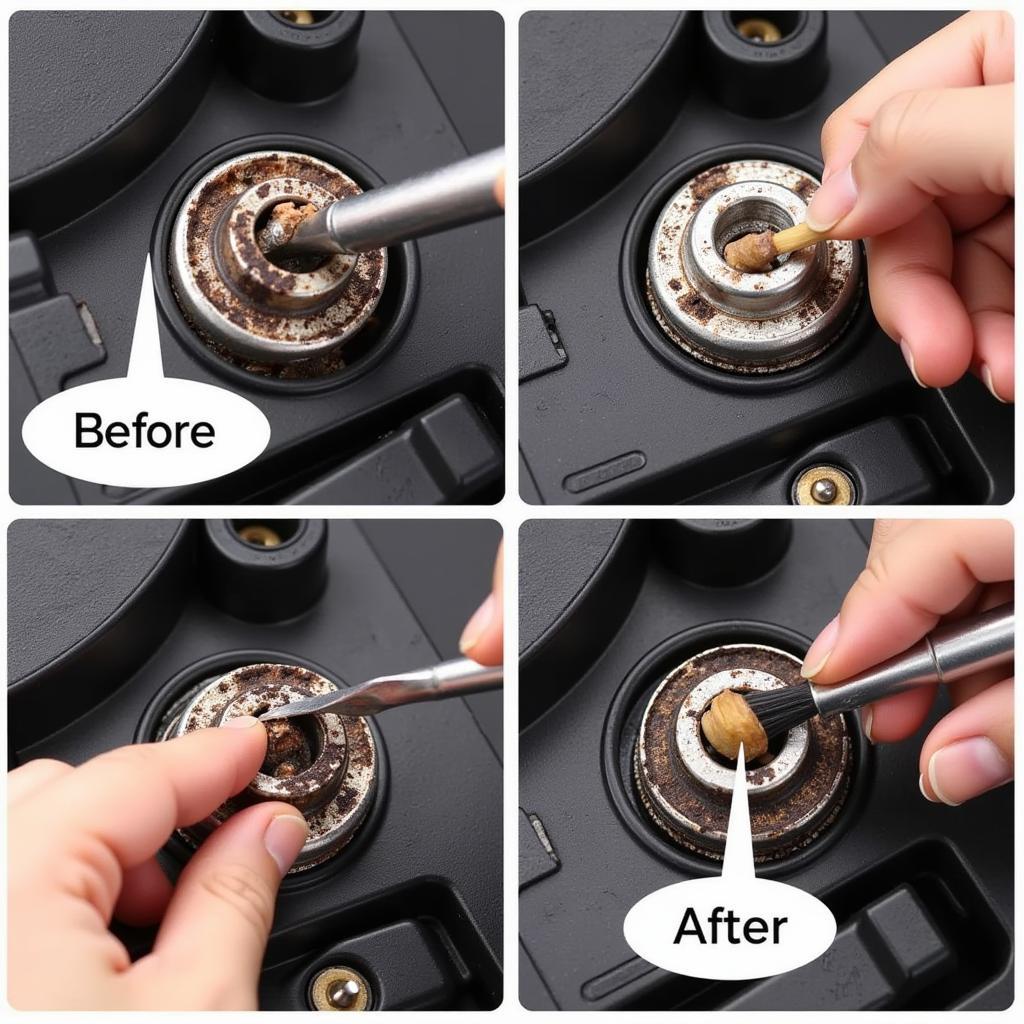The yellow brake pad warning light on your Audi A4 B8 dashboard can be a nuisance, especially when you’re unsure what triggered it. This comprehensive guide will walk you through the possible causes and provide step-by-step instructions on how to reset the warning light, including potential software-related issues that might require remote diagnostics and programming solutions.
 Audi A4 B8 dashboard with illuminated brake pad warning light
Audi A4 B8 dashboard with illuminated brake pad warning light
Understanding Your Audi A4 B8 Brake Pad Warning Light
The brake pad warning light on your Audi A4 B8 is part of the brake wear sensor system. This system is designed to alert you when your brake pads have worn down to a point where they need to be replaced. It does this through a small sensor wire embedded within the brake pad itself. Once the pad wears down to a certain level, the sensor wire makes contact with the brake rotor, completing a circuit and triggering the warning light on your dashboard.
Common Reasons for the Brake Pad Warning Light
While worn brake pads are the most common culprit, other factors can also cause the warning light to illuminate:
- Worn Brake Pad Sensors: Sometimes, the sensor wire itself can become damaged or worn, leading to a premature warning light.
- Faulty Wiring: A loose connection or damaged wire within the brake pad sensor system can also trigger the warning light.
- Low Brake Fluid: Though a separate warning light typically indicates low brake fluid, it can sometimes be linked to the brake pad warning light.
- Software Glitch: Modern cars like the Audi A4 B8 are heavily reliant on software. A glitch in the car’s electronic control unit (ECU) can sometimes lead to a false warning light.
Resetting the Audi A4 B8 Brake Pad Warning Light After Pad Replacement
If you’ve replaced your brake pads and the warning light persists, you’ll need to reset the system:
- Turn the ignition to the “on” position without starting the engine. This powers up the car’s electronics.
- Press and hold the brake pedal for 10-15 seconds. This action resets the brake pad warning system in some Audi models.
- Turn the ignition off and then back on. Check to see if the warning light has been reset.
 Mechanic replacing brake pads on an Audi A4 B8
Mechanic replacing brake pads on an Audi A4 B8
When a Simple Reset Doesn’t Work: Software-Related Issues
Sometimes, the brake pad warning light remains on even after replacing the pads and attempting a manual reset. This scenario often points to a potential software-related issue:
- Sensor Calibration: The new brake pad sensors might need to be calibrated with the car’s ECU. This process requires specialized diagnostic equipment.
- Software Update: In some cases, an outdated software version in the ECU can cause conflicts with the brake pad sensor system. A software update might be necessary.
The Benefits of Remote Diagnostics and Programming
Addressing software-related issues often requires the expertise of trained technicians and specialized equipment. However, with advancements in remote diagnostics and programming, you can now access these services more conveniently and efficiently.
How it works:
- A certified technician remotely accesses your car’s ECU using a specialized software interface.
- They perform a comprehensive diagnostic scan to identify the root cause of the warning light.
- If a software issue is detected, the technician can remotely upload and install the necessary updates or calibrations.
Benefits:
- Convenience: Skip the trip to the mechanic and have the issue addressed from the comfort of your home or office.
- Speed: Remote diagnostics and programming are often quicker than traditional methods, saving you valuable time.
- Accuracy: Experienced technicians using advanced software can pinpoint and resolve issues with a high level of accuracy.
“Remote diagnostics and programming allow us to address software-related issues more efficiently, saving our customers time and hassle,” says John Smith, a senior automotive diagnostic technician at XYZ Auto Services. “It’s a game-changer in the automotive repair industry.”
[05 impala random brake warning forum]
Addressing Persistent Brake Pad Warning Light Issues
If the brake pad warning light on your Audi A4 B8 continues to illuminate despite trying the aforementioned steps, it’s crucial to consult a qualified mechanic or an Audi dealership. They have the expertise and equipment to diagnose and rectify any underlying mechanical or electrical issues that might be causing the problem.
Conclusion
While a persistent brake pad warning light can be frustrating, understanding its potential causes and the solutions available can save you time, money, and stress. Remember, regular maintenance and timely attention to warning lights are essential for ensuring the safety and longevity of your Audi A4 B8.
[low brake fluid warning tight 2003 chevy impala]
FAQs
1. How often should I replace my Audi A4 B8 brake pads?
Brake pad lifespan varies greatly depending on driving style and conditions. However, it’s generally recommended to have them inspected every 10,000-12,000 miles and replaced as needed.
2. Can driving with worn brake pads damage my car?
Yes, driving with worn brake pads can lead to damage to the rotors, calipers, and other brake system components, resulting in costly repairs.
3. Is it safe to drive with the brake pad warning light on?
While it might be possible to drive a short distance, it’s not recommended. Continuing to drive with worn brake pads compromises your safety and can lead to brake failure.
4. How much does it cost to replace brake pads on an Audi A4 B8?
The cost of brake pad replacement varies depending on location, dealership vs. independent mechanic, and the type of brake pads used.
5. Can I reset the brake pad warning light myself?
Yes, you can attempt a manual reset using the steps outlined above. However, if the issue is software-related, you might need professional assistance.
6. What is the difference between a brake pad warning light and a brake system warning light?
The brake pad warning light specifically indicates worn brake pads. In contrast, the brake system warning light is a general warning that could indicate various issues, including low brake fluid or a problem with the ABS system.


